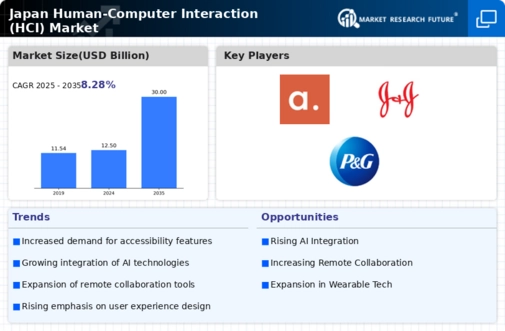Market Growth Projections
The Global Japan Human-Computer Interaction HCI Market Industry is poised for substantial growth, with projections indicating a market size of 12.5 USD Billion in 2024 and an anticipated increase to 30 USD Billion by 2035. This growth trajectory suggests a compound annual growth rate of 8.28% from 2025 to 2035. Such projections highlight the increasing importance of HCI in various sectors and the potential for innovative solutions that enhance user experience. The market's expansion is likely to be driven by technological advancements, user-centric design, and the integration of HCI across diverse applications.
Technological Advancements
The Global Japan Human-Computer Interaction HCI Market Industry is experiencing rapid technological advancements that enhance user experience and interaction. Innovations in artificial intelligence, machine learning, and natural language processing are driving the development of more intuitive interfaces. For instance, voice recognition technology is becoming increasingly prevalent in consumer electronics, allowing users to interact seamlessly with devices. This trend is expected to contribute significantly to the market's growth, with projections indicating a market size of 12.5 USD Billion in 2024. As these technologies evolve, they are likely to reshape user expectations and interaction paradigms.
Rising Adoption of Smart Devices
The proliferation of smart devices is significantly influencing the Global Japan Human-Computer Interaction HCI Market Industry. As consumers increasingly adopt smartphones, tablets, and smart home devices, the demand for intuitive and responsive interfaces grows. This trend is evident in the development of touchless interfaces and gesture recognition technologies that enhance user interaction. The market is projected to reach 12.5 USD Billion in 2024, driven by the need for seamless connectivity and interaction across devices. The ongoing evolution of smart technology is likely to further accelerate this growth, creating new opportunities for HCI innovations.
Integration of HCI in Various Sectors
The integration of HCI principles across various sectors is a notable driver for the Global Japan Human-Computer Interaction HCI Market Industry. Industries such as healthcare, education, and automotive are increasingly adopting HCI technologies to enhance operational efficiency and user engagement. For example, telemedicine platforms utilize HCI to improve patient interactions, while educational tools leverage interactive interfaces to facilitate learning. This cross-sector integration not only broadens the application of HCI but also stimulates market growth, with a compound annual growth rate of 8.28% anticipated from 2025 to 2035.
Focus on Accessibility and Inclusivity
A heightened focus on accessibility and inclusivity is shaping the Global Japan Human-Computer Interaction HCI Market Industry. Organizations are increasingly aware of the need to create products that cater to diverse user groups, including those with disabilities. This awareness is driving the development of adaptive technologies and inclusive design practices that enhance user interaction for all. As a result, companies that prioritize accessibility are likely to gain a competitive edge in the market. This trend aligns with the projected growth of the industry, which is expected to reach 30 USD Billion by 2035, reflecting a broader commitment to inclusivity in technology.
Increased Demand for User-Centric Design
There is a growing emphasis on user-centric design within the Global Japan Human-Computer Interaction HCI Market Industry. Organizations are increasingly recognizing the importance of designing products and services that prioritize user needs and preferences. This shift is evidenced by the rise of user experience (UX) research and design methodologies, which aim to create more engaging and effective interactions. Companies that invest in user-centric design are likely to see improved customer satisfaction and loyalty. As the market matures, the focus on user-centric approaches may drive the industry towards a projected market size of 30 USD Billion by 2035.














Leave a Comment